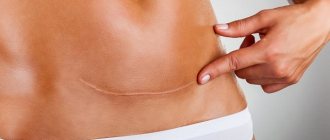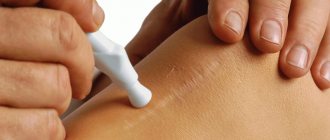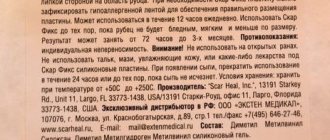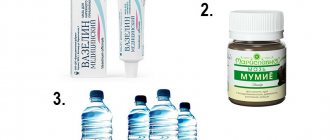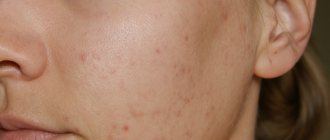Excision of facial scars is represented by plastic surgery measures aimed at eliminating a cosmetic defect using various techniques, the choice of which depends on its characteristics and area of location. The scar itself is a dense connective formation formed during the process of tissue regeneration after:
- surgical intervention;
- skin damage;
- inflammatory processes;
- ulcerative lesions.
It is mainly composed of fibrillar protein, which forms the basis of the connective tissue of the human body and is known as collagen. It is visually different from the tissues it replaces and is not as functional. They resort to removing scars on the face and body because they stand out against the background of healthy skin and spoil the appearance, often being a source of complexes and psychological problems.
Excision of scars (keloid, atrophic) - on the face (1cm) - 14,000 rubles.
Excision of scars (keloid, atrophic) - on the body (1cm) - 8,000 rubles.
Included in the price:
surgery, consultation with an anesthesiologist, anesthesia/anesthesia, hospital stay with meals, dressings, postoperative observation by the attending physician for a month.
1-3 days in hospital
Removal of scars on the face and body in Moscow
Modern plastic surgery offers effective techniques for removing scars on the body and face. You can order services in this area at the plastic surgery department of CELT.
We employ specialists with decades of experience. They have mastered excision techniques and consistently achieve excellent results, restoring beauty to patients. The process uses modern equipment and effective anesthesia drugs.
Particular attention is paid to diagnosis, which allows us to identify and eliminate contraindications and minimize the risk of complications. Our clinic is multidisciplinary and has its own laboratory and diagnostic department. If necessary, our patients can consult with highly specialized specialists in various fields.
To find out the price for removing scars on the face and body, go to the “Services and prices” tab in this section. It is calculated per 1 centimeter and will cost more on the face. To avoid misunderstandings, find out the exact numbers by contacting our operators.
Possible complications
Surgical removal of moles is a simple operation that in most cases does not cause any complications. But sometimes they still arise. Most often, allergic reactions to pain medications are observed. To prevent this from happening, you need to discuss this issue with the doctor before the operation and ask him to choose the most suitable medication.
Some patients experience bleeding, swelling, itching, burning, and pain. During the operation, an infection may enter the wound and inflammation will begin. To avoid this, all manipulations must be carried out under sterile conditions in compliance with all surgical rules.
Another postoperative complication is the formation of scars and keloids. In some cases, the patient may need another operation to get rid of them.
To successfully remove a nevus and minimize the risk of complications, contact only trusted clinics and follow all doctor’s recommendations for wound care in the postoperative period.
Preparation for scar excision surgery and its implementation
Since excision is a full-fledged operation (sometimes not an easy one), it requires complex preparation. In addition to attending a preliminary consultation and discussing the desired results with a plastic surgeon, the patient needs to undergo diagnostic tests:
- General blood and urine analysis;
- Electrocardiography;
- Test for an allergic reaction to anesthesia drugs;
- Tests for HIV and hepatitis.
It is important for the patient to understand that complete removal of the scar is impossible - it will still remain - however, it is within the power of the surgeon to make it almost invisible and reduce its size. Two weeks before surgery, you should avoid taking blood thinning medications, as well as smoking. If you plan to use general anesthesia, your last meal should be no later than ten hours before visiting the surgeon.
The surgical excision technique is selected individually, based on the following parameters:
- Indications and wishes of the patient;
- Features of the scar;
- Functional disorders caused by its presence;
- Scar location.
Depending on the volume, the intervention is performed under local or general anesthesia. The surgeon’s actions are aimed at recreating the incision and moving the skin around it in order to minimize tension. Removal is carried out by excision in such a way that the wound edges can be easily compared, after which a cosmetic suture is applied. It is removed after three to four days.
To make rehabilitation easier and the operation to give the best result, the patient is prescribed a number of procedures. After the operation, a thin seam remains on the skin, which is practically invisible.
Do you want the best result? Contact CELT! Our plastic surgeons have been successfully removing scars from burns, injuries, and surgeries for several years now.
Advantages and disadvantages of the surgical method
Removing a mole surgically has its advantages.
- Allows you to remove large nevi, as well as those located in the deep layers of the skin.
- The method allows you to effectively remove malignant tumors. The doctor excises not only the nevus itself, but also nearby tissues that may contain cancer cells. Other methods destroy only the birthmark itself.
- The surgical method allows you to remove the mole in one go. As a result of using other methods, the nevus may reappear, and the patient will have to return to the clinic again. The use of surgery eliminates this.
- After excising the mole, the doctor can take a tissue sample and send it to the laboratory for histological examination. Electrocoagulation, cryodestruction or laser method do not allow collecting biomaterial.
- This method is completely safe, since the operation is performed in a hospital under sterile conditions and under the supervision of a doctor.
- The surgical method is one of the cheapest. Not every patient can afford modern, expensive methods (laser or radio wave surgery). Surgical removal of a mole is inexpensive.
- Removing a birthmark surgically is not painful at all, since all manipulations are carried out under local anesthesia.
- There are not many contraindications to such treatment.
In addition to obvious advantages, this method also has some disadvantages.
- The consequence of the operation may be the appearance of a noticeable scar or keloid scar at the site of the former formation. Because of this, moles on the face or neck are not recommended to be removed surgically.
- The postoperative period is quite long (several weeks).
- For some time after the procedure, the patient should avoid sunlight and all external influences. Sometimes a patient who has undergone such an operation cannot sunbathe in the sun or in a solarium for several months or even years.
Preparation and performance of the operation
In order for the operation to be successful and as a result you get smooth skin that is not spoiled by the scar, you need to undergo a number of preparatory procedures.
Specialist consultation
Before reducing a scar, you should consult with your doctor, who will familiarize you with the possible risks, complications and give recommendations regarding the postoperative period.
You must be prepared for the fact that the operation will not completely get rid of the scar, but will make it invisible and located in the right direction. Moreover, after the procedure is completed, it is necessary to carefully care for the wound to prevent its progression.
Preparation for the procedure
First of all, you will need to pass all the tests and be examined. If the operation must be performed under anesthesia, it is worth discussing this with the anesthesiologist in advance. To obtain a visible result before surgery, you must follow a diet, abstain from alcoholic beverages and take vitamins.
If you are taking any medications at the time of surgery, you should notify your doctor. Also, the doctor should be aware of the presence of allergies to medications, especially novocaine and lidocaine.
Day of surgery
It is worth rinsing the area where the scar is located well without using cosmetics. If the operation is planned under anesthesia, you should not eat or drink liquids that day. Directly at the clinic, they will take a picture of the scar and send you to the operating room.
Excision procedure
Under local anesthesia, the scar is excised using a scalpel or laser, then its edges are raised and the vessels are coagulated. At the end of the operation, stitches are placed on the wound.
Postoperative care
In order for the operation to have a favorable outcome, it is necessary to take a responsible approach to caring for the wound after it is performed.
Immediately after the procedure, you will be placed in a pressure bandage for 24 hours to stop bleeding. For several months, it is worth protecting the scar from direct sunlight, various injuries and damage.
Surgery
At the moment, there are many methods of surgical excision of scars. When choosing a specific method, the specialist pays attention to the density, size, and type of scars. What is important is the condition of the skin surrounding the scar, and the position of the scar relative to other landmarks of the human body.
Much attention is paid to complex scars that arise as a result of surgical operations, after serious burns, and deep injuries. What features does the operation have:
- Small scars that protrude slightly above the skin level are excised with a scalpel or blade parallel to the skin. Here it is very important not to cut off too much, to avoid this, the raised part of the scar is marked. Uneven boundaries between the removed scar and healthy skin are corrected using electrosurgical instruments. The healing of such a wound occurs by secondary intention, that is, it is not sutured.
- Another common method of scar excision is spindle-shaped or elliptical excision. Typically used to treat scars that run across the natural lines of a person's skin. An incision is made across the scar, so that the new one coincides with the natural line, the edges are excised slightly and finished with sutures. A temporary suture is applied if the original scar was long enough, and then the operation requires several such approaches to completely remove the old scar. The result is a new scar, made across the old one, so that it matches the natural lines on the skin and does not stand out. Its healing occurs under correction and supervision, so that the result is a neat, almost invisible defect. If the scar was initially hypertrophic, then it is first excised to level it with the level of the skin, so the entire course of correction can sometimes take six months or a year. Patients must be prepared for this.
- Skin grafting and flap plastic surgery are popular. Thanks to these methods, it is possible to move a serious scar from a cosmetic area to less noticeable places on the human body. I often use it for burns and keloid scars. The scar is excised and the area is covered with skin from the donor site. As a result, instead of a scar, almost invisible small scars remain. This result is considered acceptable.
- In dentistry, excision and plastic surgery of scars on the oral mucosa are also used. Sometimes, atypical scars are found on the mucous membrane, and they are excised because they interfere with prosthetics. Among these operations on the oral mucosa, various types of plastic surgery and transplantation are also used.
In addition to these techniques, there are other types of plastic surgery, for example, W-plasty or Z-plasty and others, it all depends on the type of scar. But all methods are effective, and these are the results you can achieve if you approach the problem responsibly:
In any case, surgical excision or scar plastic surgery are radical techniques. Doctors advise resorting to them if the problem is really serious and other types of therapy do not help.
Execution technique
Two lines are drawn on the skin, parallel to the natural lines on the body and at an angle of 60° to the original scar. These lines show the locations of future incisions and should be equal to or slightly longer than the scar (the length depends on the elasticity of the skin). The shape of the pattern on the skin will be similar to the letter “Z”.
After excision of the scar and incisions along the intended lines, triangular flaps of skin are formed. They are moved in such a way that a new letter “Z” is formed, positioned differently than the original one. The new scar will be parallel to the natural lines, but will lengthen by 75%.
The location of the center line in the letter "Z" can be visualized by mentally connecting the free ends of the original letter "Z". How much longer the new scar will be compared to the original depends on the angle between the arms of the original "Z" and the original scar. As a general rule, for every 15° increase in angle, the new scar lengthens by 25%.
| Scar lengthening with Z-plasty | |
| Z-plasty angle, ° | Scar lengthening, % |
| 30 45 60 | 25 50 75 |
By performing a Z-plasty several times on small areas of the scar, you can reduce skin tension and create several new scars along natural lines. To increase the mobility of the skin flaps, soft tissue is dissected subcutaneously around the scar. The ends of the flaps should not be taut, otherwise necrosis may occur.
| Z-plasty (scheme) |
|
|
Surgical removal of tumors
This is a classic technique in which the formation is excised with a scalpel and then a cosmetic suture is applied. It is the most effective and allows you to remove large moles or conglomerates. Surgery is chosen because the melanocytes that make up nevi can lie deep in the tissue. If after treatment with a laser or radio wave at least one melanocyte “survives”, then a new growth will grow in this place again. At best, it will be pigmentation, and at worst, it will lead to melanoma, because a nevus that has been injured tends to quickly degenerate into cancer. Therefore, surgical excision is the most reliable way to remove the formation. With it, melanocytes are not just killed, but cut out along with a small area of the surrounding skin. Advantages:
- the main thing is that the removed material can be sent to the laboratory for histological examination to rule out cancer;
- 100% reliability and effectiveness;
- Duration of the operation – 5-7 minutes per mole;
- no pain.
The disadvantage is a small scar at first after the operation, which at first looks like a pink spot and then gradually disappears.


